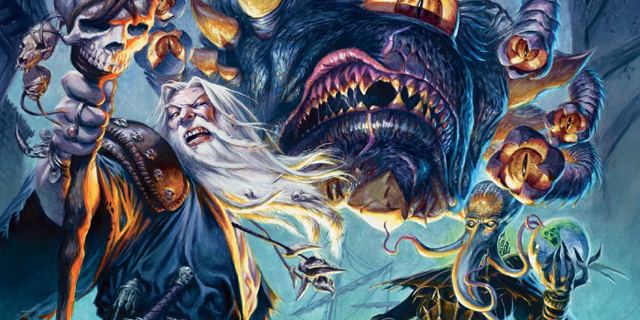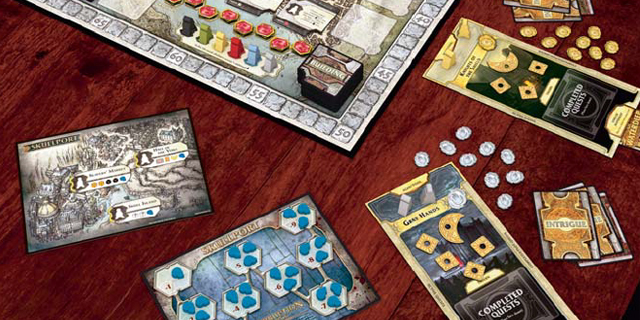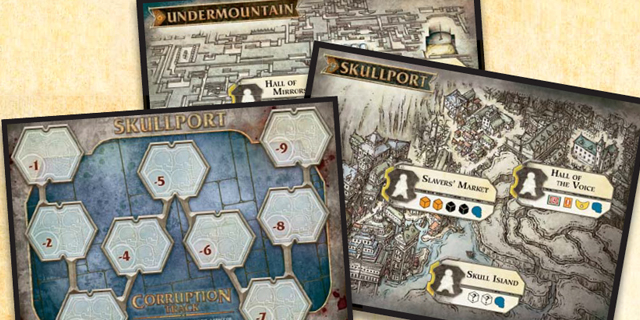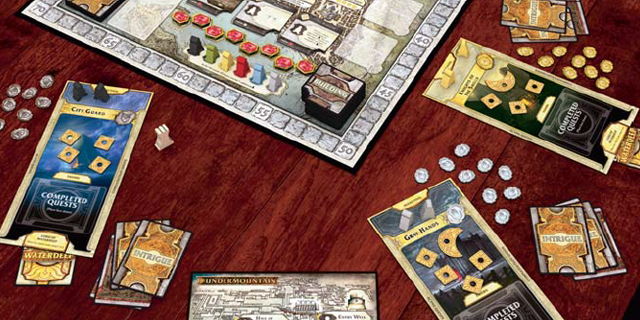
Lords of Waterdeep is still a great game that sees a lot of play in many groups, but maybe it’s getting a little old by now. And did you ever notice that sixth agent space on the round five holding area? Obviously that board was designed with expansion in mind, and that expansion has finally arrived with Scoundrels of Skullport. Or, more accurately, expansions.
The box labeled Scoundrels of Skullport is actually two modular expansions for Waterdeep. The first is the corrupt (and presumably scoundrel-infested) Skullport, and the other is the high-risk, high-reward Undermountain. They can be added to the base game individually without any effort, although using both will require some cards and advanced buildings to be removed first.
Each module has three new Lord cards, 25 new Intrigue cards, 30 new Quests and 12 advanced buildings. Also included in the box are everything you need for a sixth player (play mat, agents, building control markers, scoring marker, and 100 VP token), additional agents for the original colors (if you want to play a longer two-player session), and “caravans” that represent five of a given type of adventurer cube. Additionally, there are some rules clarifications and errata for the base game in the rule book. As with the base game, these components (and the module-specific ones) fit in a carefully-engineered insert that keeps the two modules separate for easy access. Everything “belonging” to a given module has its “expansion symbol” printed on it to aid in post-game separation.

Since it gets title billing, I might as well discuss the Skullport module first. Skullport’s main feature is Corruption, represented by blue wooden skulls. You can — and will — gain these tokens as part of various actions or rewards, often along with a larger-than-usual amount of other resources. For example, if you visit the Slavers’ Market basic building, you will earn one Corruption but also two Warriors and two Rogues! And that’s just a basic building! The Corruption markers begin the game on the Corruption Track, which will determine their eventual penalty value at the end of the game. This track has a number of “wells” on it, and the deepest completely empty well is what determines how much each Corrpution token will penalize you. Should the track already be completely empty (-9 value) when you need to take one, you are penalized ten points immediately!
Of course, gaining Corruption is only one half of the equation here. A number of quests provide much smaller rewards than normal but also allow you to return Corruption to the track and thus not only removing some of your final penalty but also mitigating the overall effect of Corruption for everyone. There are also some effects that remove Corruption, which gets them off your back but doesn’t do anything to the final value except ensure that it will never be zero. Careful management of your Corruption will be critical to success when dealing with Skullport and its nefarious occupants.
While the inhabitants of Undermountain are probably no less nefarious, they are more immediately dangerous. As any D&D veteran will tell you, the deeper you go the more trouble you undoubtedly get into. Undermountain is the home of the Drow (dark elves) and other opposing forces that will require great strength to over come. The theme of the Undermountain module is “great demand, great rewards.” For example, there are quests with outrageous requirements to complete that pay off a staggering 40 VP if you pull them off. To aid you in these and other epic missions, many of the new buildings provide additional resources or allow you to play several Intrigue cards with one action.

Both modules make use of a new mechanic: placing resources on action spaces. If an action requires you to do this, you can put them on any space, occupied or not. The first player to assign an agent to that space collects whatever is there before executing that action, and can even use those resources to do so if they wish. This is similar in feel to many of the base set Intrigue cards that give you something and give an opponent of your choice a lesser version of what you got, only with less control over who reaps your side bounty.
While I haven’t yet tried a game with both modules, I have played a six-player game with each one and the results were interesting. Undermountain seemed to make the game take much longer, as more complicated turns were going on, often involving a bunch of Intrigue cards. I actually played six with one action at one point (and could have played a seventh), but that was due to a combination of a couple of effects. Our Skullport session, on the other hand, was much like any other game of Waterdeep and flew by comparatively quickly. But I’ve also seen a Skullport session take much, much longer than normal so it might have to do with the specific mix stuff and even players involved.
Being able to add a sixth player is welcome, even if by definition you are playing a “long” game. You can now play “long” games with fewer than six as well by using at least one module and starting each player with an additional agent. Including sixth agents for all six potential player colors seems like overkill, but ultimately harmless.

Not so harmless are some questionable quality control hiccups with some of the materials in this box. All of the Quest cards (including the Mandatory Quests) are printed in the opposite orientation from those in the base set, which isn’t a big deal but seems odd and at least makes sorting them out a little easier. The cards themselves are also a slightly different size from those in the base set; not enough that you can notice it by casual sight or even necessarily by feel, but enough that it will cause clumping when using traditional shuffling methods. Given Wizards of the Coast’s 20-year history of producing card games this seems like a very curious oversight and quite possibly the printer’s fault.
And it’s not just the cards either, as some of my new Agents are cut wider or thicker than normal, to the point where it is actually difficult to get a couple of them in the designated space in the insert. These size issues might be corrected in future runs, but for now be aware that they exist if you don’t sleeve your cards. Fortunately these are minor problems in the grand scheme of things, but I (and others) expect more from WotC, and this is somewhat disappointing coming from them.
Still, minor production issues aren’t enough to take the fun away from using either module (or both). As long as you realize that sessions will probably take longer than just using the base set, including extra set up and tear down times, both expansions in Scoundrels of Skullport are worth trying if you already enjoy Lords of Waterdeep.
Scoundrels of Skullport retails for $40.



















